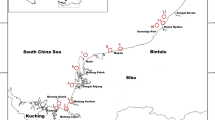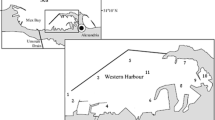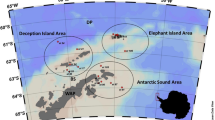Abstract
Tintinnid species distribution and hydrography were studied in the coastal waters of Digha during winter (November 2015) and summer (March 2016) seasons. Surface water samples were collected from 11 different stations from 0 to 10 km offshore with the help of a mechanized trawler. Parameters like tintinnid species enumeration, zooplankton biomass, phytoplankton concentration (total chlorophyll) and abundance, sea surface temperature (SST), pH, transparency, salinity, dissolved oxygen (DO), total phosphate, silicate and nitrate were analysed. A total of 20 different tintinnid species (16 agglomerated +4 non-agglomerated) belonging to 6 genera were recorded from the study area with seasonal variation in tintinnid diversity, i.e. higher in summer (total 2745 individual/l) compared to winter (total 1191 individual/l). Tintinnopsis was the most dominant genus during both the seasons, i.e. 2100 individual/l in summer and 727 individual/l in winter, contributing about 76 and 61% population for the respective seasons. The correlation between species and water quality parameters showed that Tintinnopsis sp. abundance was significantly regulated by nitrate concentration, salinity, dissolved oxygen, water transparency and pH. However, the mentioned hydrological parameters were not the only factors regulating the tintinnid abundance. Tintinnid abundance was also found to be positively related with transparency (r = 0.732) and salinity (r = 0.524) and moderately related with dissolved oxygen (r = 0.488) whereas strong negative relation (at p ≤ 0.05) was established between tintinnid abundance with nitrate (r = −0.681) and pH (r = −0.561). Bray-Curtis cluster analysis of tintinnid species showed more than 60% similarity. Shannon’s diversity index (H′), Simpson’s evenness index (D) and Margalef’s species richness index were found to be higher in summer, i.e. 1.61, 0.729 and 1.612, compared to the winter season, i.e. 1.139, 0.597 and 1.268. k-dominance curve showed maximum abundance of Tintinnopsis baltica in winter and Tintinnopsis gracilis in summer. Principal component analysis (PCA) was analysed to find out the environmental variables affecting different tintinnid species diversity. A significant spatiotemporal variation in Tintinnid population distribution was observed from two-way ANOVA. The results reflect significant seasonal (F = 840.0), spatial (F = 47.3) and interactive variation (F = 71.2) among the ciliate microzooplankton at n = 66, p ≤ 0.001. High chlorophyll content and phytoplankton population in summer indicated that tintinnid diversity in the season was positively influenced by producer community in coastal waters of Digha.








Similar content being viewed by others
References
Abboud-Abi Saab, M. (1989). Distribution and ecology of tintinnids in the plankton of Lebanese coastal waters (eastern Mediterranean). Journal of Plankton Research, 11(2), 203–222.
Acharya, M. S., Panigrahi, S., Satpathy, K. K., Sahu, G., Mohanty, A. K., Selvanayagam, M., & Panigrahy, R. C. (2014). Nutrient dynamics and seasonal variation of phytoplankton assemblages in the coastal waters of southwest Bay of Bengal. Environmental Monitoring and Assessment, 186, 5681–5695.
Angel, E. S., & Cepeda, E. O. (1992). Tintinnids from Todos Santos Bay, B.C. Mexico (1980- 1985). I. Taxonomy. Ciencias Marinas, 18(2), 171–197.
Balkis, N. (2004). Tintinnids (protozoa: Ciliophora) of the Buyukcekmece Bay in the Sea of Marmara. Scientia Marina, 68(1), 33–44.
Balkis, N., & Koray, T. (2014). A check-list of Tintinnids (protozoa: Ciliophora) in the coastal zone of Turkey. Pakistan Journal of Zoology, 46(4), 1029–1038.
Balkis, N., & Toklu-Ahch, B. (2009). Tintinnid (protozoa: Ciliophora) species in the Edremit Bay. Istanbul University Faculty of Sciences Journal of Biology, 68(1), 47–53.
Biswas, H., Gadi, S. D., Ramana, V. V., Bharathi, M. D., Priyan, R. K., Manjari, D. T., & Kumar, M. D. (2012). Enhanced abundance of tintinnids under elevated CO2 level from coastal Bay of Bengal. Biodiversity and Conservation, 21, 1309–1326.
Biswas, S. N., Godhantaraman, N., Rakshit, D., & Sarkar, S. K. (2013). Community composition, abundance, biomass and production rates of Tintinnids (Ciliata: Protozoa) in the coastal region of Sundarban mangrove wetland, India. Indian Journal of Geo-Marine Sciences, 42(2), 163–173.
Bojanic, N., Vidjak, O., Solic, M., Krstulovic, N., Brautovic, I., Matijevic, S., Kuspilic, G., Sestanovic, S., Gladan, Z. N., & Marasovic, I. (2012). Community structure and seasonal dynamics of tintinnid ciliates in Kastela Bay (middle Adriatic Sea). Journal of Plankton Research, 34(6), 510–530.
Cosper, T. C. (1972). The identification of Tintinnids (protozoa: Ciliata: Tintinnida) of the St. Andrew bay system. Florida. Bulletin of Marine Science, 22(2), 390–418.
Dolan, J. R., Landry, M. R., & Ritchie, M. E. (2013). The species-rich assembladges of tintinnids (marine planktonic protists) are structured by mouth size. The International Society for Microbial Ecology Journal, 7, 1237–1243.
Elangovan, S. S., Kumar, M. A., Karthik, R., Sankar, R. S., Jayabarathi, R., & Padmavati, G. (2012). Abundance, species composition of microzooplankton from the coastal waters of Port Blair, south Andaman Island. Aquatc Biosystems, 8(20), 1–9.
Gifford, D. J. (1991). The protozoa-metazoan trophic link in the pelagic ecosystem. Journal of Protozoology, 38, 81–86.
Goswami, S. C. (2004). Zooplankton methodology, collection and identification—a field manual. Goa: National Institute of Oceanography.
Hargraves, P. E. (1981). Seasonal variations of tintinnids (Ciliophora: Oligotrichida) in Narragansett Bay, Rhode Island, U.S.A. Journal of Plankton Research, 3(1), 81–91.
Hua-xue, L., Liang-min, H., Ye-hui, T., Xing-yu, S., Jian-rong, H., & Tao, L. (2010). Distribution and composition of tintinnids ciliates in the northern South China Sea during summer. Marine Science Bulletin, 12(2), 38–46.
John Peter Paul, J. (2012). Seasonal variation in water temperature on the south east coast of Tamil Nadu, India. Journal of Environmental Science, Computer Science and Engineering & Technology, 1(3), 488–491.
Jyothibabu, R., Madhu, N. V., Maheswaran, P. A., Jayalakshmy, K. V., Nair, K. K. C., & Achuthankutty, C. T. (2008). Seasonal variation of microzooplankton (20-200μm) and its possible implications on the vertical carbon flux in the western Bay of Bengal. Continental Shelf Research, 28, 737–755.
Kamiyama, T., & Tsujino, M. (1996). Seasonal variation in the species composition of tintinnid ciliates in Hiroshima Bay, the Seto Inland Sea of Japan. Journal of Plankton Research, 18(12), 2313–2317.
Kimor, B., & Golandsky-Baras, B. (1981). Distribution and ecology of the tintinnids in the Gulf of Elat (Aquaba), Red Sea. Journal of Plankton Research, 3(3), 445–459.
Krinsic, F. (1987). On the ecology of tintinnines (Ciliata-Oligotrichida, Tintinnina) in the open waters of the south Adriatic. Marine Biology, 68, 83–90.
Kumar, C. S., & Perumal, P. (2011). Hydrological investigations in Ayyampattinam coast (southeast coast of India) with special reference to zooplankton. Asian Journal of Biological Sciences, 4, 25–34.
Li, H., Xu, Z., Ahang, W., Wang, S., Zhang, G., & Xiao, T. (2016). Boreal Tintinnid assemblage in the Northwest Pacific and its connection with the Japan Sea in summer 2014. PloS One, 11(4), 1–16.
Manna, B., Banerjee, S., Aditya, G., & Chattopadhyay, J. (2008). Study of marine planktonic diversity in Digha coast, Bay of Bengal. Zoological Research in Human Welfare, 3, 49–54.
Modigh, M., Castaldo, S., Saggiomo, M., & Santarpia, I. (2003). Distribution of tintinnid species from 42°N to 43°S through the Indian Ocean. Hydrobiologia, 503, 251–262.
Nagano, N., Iwatsuki, Y., Kamiyama, T., & Nakata, H. (2000). Effects of marine ciliates on survivability of the first—feeding larval surgeonfish, Paracanthurus hepatus: laboratory rearing experiments. Hydrobiologia, 432, 149–157.
Porra, R. J., Thompson, W. A., & Kriedemann, P. E. (1989). Determination of accurate extinction coefficients and simultaneous equations for assaying chlorophylls a and b extracted with four different solvents: verification of the concentration of chlorophyll standards by atomic absorption spectroscopy. Biochimica et Biophysica Acta, 975, 384–394.
Rakshit, D., Biswas, S. N., Sarkar, S. K., Bhattacharya, B. D., Godhsntaraman, N., & Satpathy, K. K. (2014). Seasonal variation in species composition, abundance, biomass and production rate of tintinnids (ciliate:Protozoa) along the Hooghly (Ganges) river estuary, India : a multivariate approach. Environmental Monitoring and Assessment, 186, 3063–3078.
Rakshit, D., Sarkar, S. K., Satpathy, K. K., Ganesh, P. S., Godhantaraman, N., & Biswas, J. K. (2016). Diversity and distribution of microzooplankton Tintinnid (Ciliata: Protozoa) in the core region of India Sundarban wetland. Clean-Soil, Air, Water, 44(9999), 1–9.
Sridhar, R., Thangaradju, T., Kumar, S. S., & Kannan, L. (2006). Water quality and phytoplankton characteristics in the Palk Bay, southeast coast of India. Journal of Environmental Biology, 27(3), 561–566.
Strickland, J. D., & Parsons, T. R. (1972). A practical handbook of seawater analysis. Canada: Fisheries Research Board.
Umani, S. F., Monti, M., Cataletto, B., & Buddilon, G. (2011). Tintinnid distributions in the strait of Magellan (Chile). Polar Biology, 34, 1285–1299.
Vinayachandran, P. N., Murthy, V. S. N., & Ramesh Babu, V. (2002). Observations of barrier layer formation in the Bay of Bengal during summer monsoon. Journal of Geophysical Research, 107(C12), 8008.
Wasik, A., & Mikolajczyk, E. (1994). Annual cycle of tintinnids in the Admiralty Bay with an emphasis on seasonal variability in Cymatocylis affinis/convallaria lorica morphology. Journal of Plankon Research, 16, 1–8.
Acknowledgement
The authors are thankful to Meteorology and Oceanography Program (MOP-3) of Indian Space Research Organization (ISRO) and Director, Space Applications Centre, Ahmedabad for the financial support and encouragement and The Head, Department of Zoology, Department of Botany, Ravenshaw University, Cuttack, for providing the necessary laboratory facilities to carry out the research work. We are thankful to Mr. Biswaprajna Mohanty for helping us in revising the manuscript.
Author information
Authors and Affiliations
Corresponding author
Rights and permissions
About this article
Cite this article
Dash, S., Behera, R.K., Mohapatra, P.K. et al. Species composition of microzooplankton Tintinnid from the coastal waters of Digha, Bay of Bengal. Environ Monit Assess 189, 258 (2017). https://doi.org/10.1007/s10661-017-5961-z
Received:
Accepted:
Published:
DOI: https://doi.org/10.1007/s10661-017-5961-z




